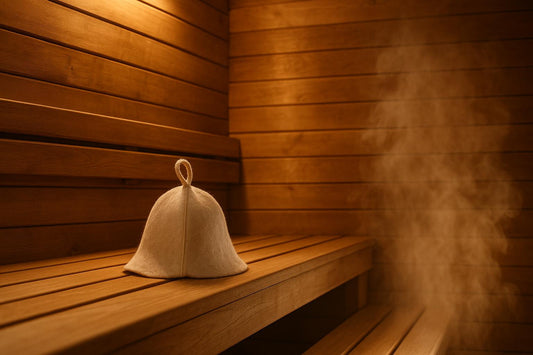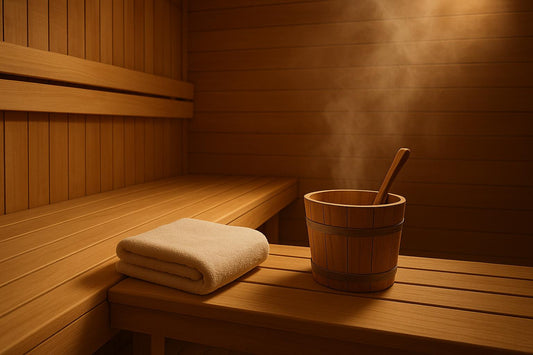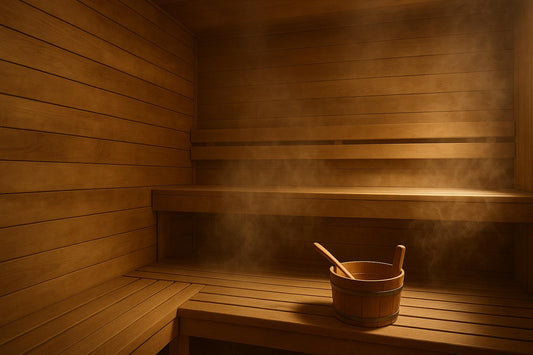In a sauna, where temperatures can reach up to 200°F, protecting your head is crucial. A sauna hat shields your head from extreme heat, prevents sweat from dripping into your eyes, and helps retain moisture in your hair. Choosing the right material can significantly enhance your sauna experience.
Here’s a quick overview of the 7 best sauna hat materials:
- Wool: Excellent heat insulation, absorbs moisture without feeling damp, and naturally resists bacteria.
- Felt: Durable, heat-resistant, and molds to your head for a secure fit.
- Cotton: Soft and breathable but poor at handling moisture and heat in long sessions.
- Linen: Breathable, dries quickly, and softens over time.
- Bamboo: Lightweight, moisture-wicking, and regulates temperature effectively.
- Synthetic Blends: Budget-friendly but limited in heat protection.
- Heat-Specific Materials: Designed for extreme heat, offering top-tier protection and durability.
Quick Comparison Table
| Material | Heat Resistance | Moisture-Wicking | Durability | Comfort | Key Benefits | Drawbacks |
|---|---|---|---|---|---|---|
| Wool Felt | 5 | 5 | 5 | 4 | Insulation, antibacterial | Higher cost |
| Linen | 4 | 4 | 4 | 5 | Breathable, eco-friendly | Less insulating than wool |
| Cotton | 3 | 2 | 3 | 4 | Affordable, soft texture | Absorbs water heavily |
| Bamboo | 4 | 4 | 3 | 5 | Lightweight, odor control | Moderate durability |
| Synthetic Blends | 2 | 3 | 4 | 3 | Budget-friendly | Weak heat protection |
| Heat-Specific | 5 | 4 | 5 | 4 | Extreme heat resistance | Expensive |
Pick a material based on your sauna routine and preferences. Wool and felt are top choices for high heat, while linen and bamboo are great for breathability. For sensitive skin, consider alpaca wool or pure linen. Proper care ensures your sauna hat lasts for years.
Why You Should Wear a Sauna Hat
1. Wool
Wool is one of the top materials for sauna hats, offering strong heat protection and excellent moisture management. Thanks to its natural properties, wool handles the intense sauna environment - where temperatures can hit 150°F to 200°F - like a pro.
One key advantage of wool is its ability to absorb up to 33% of its weight in moisture while still keeping its insulating properties. Compare that to cotton, which can soak up nearly 200% of its weight. This means a wool sauna hat stays lighter and more comfortable, even during longer sessions.
A thick wool hat also helps by blocking out excessive heat, which keeps your head cooler while ensuring your body warms evenly.
Another perk? Wool naturally resists bacteria, dirt, and odors. This makes it a cleaner and longer-lasting option - an important factor in the humid, warm conditions of a sauna.
Here’s a quick breakdown of wool's performance:
| Feature | Wool Performance | Benefits |
|---|---|---|
| Moisture Absorption | 33–35% of weight | Stays dry and lightweight |
| Temperature Control | Excellent insulation | Promotes even body heating |
| Durability | High resistance to shape loss | Maintains form over time |
| Hygiene | Natural antibacterial properties | Reduces odor buildup |
For example, premium wool sauna hats from Brooklyn's Schvitzin highlight wool’s ability to retain heat while staying comfortable.
Wool does require some care - handwashing is recommended to maintain its shape and insulation. However, its resistance to dirt and odors means you won’t need to wash it often.
Up next, we’ll take a closer look at felt, another material known for its heat-resistant properties.
2. Felt
Felt, especially wool felt, has been a go-to material for sauna hats for years. Its ability to insulate, regulate temperature, and manage moisture makes it a reliable choice for comfort and safety. Plus, it naturally molds to your head for a snug and secure fit.
Here’s a breakdown of how felt performs:
| Feature | Performance | Benefit |
|---|---|---|
| Heat Protection | Excellent insulation | Shields your head from intense ceiling heat |
| Moisture Management | Natural wicking | Keeps your head dry during sauna sessions |
| Durability | High resistance | Maintains shape and performance with proper care |
| Customization | Conforms over time | Adapts to the shape of your head for a better fit |
| Maintenance | Low effort | Easy care routine helps it last longer |
When shopping, look for hats labeled as "100% wool" or "pure wool felt" to avoid synthetic materials that don’t perform as well. For care, air-dry the hat completely, store it in a cool, breathable bag, repair small damages quickly, and use baking soda to tackle odors.
Felt is naturally antibacterial and resistant to dirt, which keeps it fresh even after multiple sauna sessions. It also provides excellent protection for your hair, guarding it against heat damage and dryness.
Up next, we’ll dive into the lightweight and breathable properties of cotton for sauna use.
3. Cotton
Cotton is a common material for sauna hats, valued for its breathability and soft texture, which make it comfortable for shorter sauna sessions. However, it struggles in high-heat environments due to how it handles moisture.
| Property | Performance | Impact on Sauna Use |
|---|---|---|
| Heat Protection | Moderate | Less effective compared to wool or felt |
| Moisture Handling | High absorption | Becomes heavy when wet |
| Drying Time | Very slow (65+ hours) | Needs thorough drying between uses |
| Comfort | Excellent | Soft and gentle on the skin |
| Temperature Regulation | Limited | Insulation weakens as fibers collapse when wet |
Cotton is great at absorbing sweat, offering short-term comfort. However, this same property becomes a drawback during longer sauna sessions. Wet cotton fibers lose their ability to insulate, pulling heat away from your body instead of retaining it. As WeatherWool explains:
"Typical cotton garments will immediately soak up as much water as they can hold, and wet cotton fiber is wet on the inside and the outside, so it pulls immense amounts of heat from your body. Cotton Kills."
To make the most of a cotton sauna hat, choose one that's loose-fitting for better airflow and light-colored to reflect heat. Proper maintenance is key: ensure the hat dries thoroughly after each use, as cotton's slow drying time can be a hassle. If you're a frequent sauna-goer, consider having multiple hats on hand to rotate between sessions. While cotton allows moisture to evaporate evenly from your skin, its poor heat retention makes it better for shorter sauna visits.
Next, we’ll see how linen stacks up in terms of comfort and heat management.
4. Linen
Linen, a natural fiber known for its high quality, is perfect for hot environments due to its excellent breathability and ability to manage moisture. Here's a quick overview of its key features:
| Property | Performance | Impact on Sauna Use |
|---|---|---|
| Heat Protection | High | Reflects heat well, especially in light colors |
| Moisture Handling | Excellent | Absorbs moisture quickly and dries fast |
| Durability | Superior | Gets softer and more comfortable with every wash |
| Breathability | Outstanding | Keeps air flowing during sauna sessions |
| Skin Comfort | Very High | Naturally gentle and non-irritating |
A great example of linen's craftsmanship comes from Jokipii in Western Finland. They create linen terry fabric sauna hats using traditional weaving techniques, avoiding chemicals entirely. These hats showcase linen's benefits while supporting eco-conscious production practices.
"Linen's moisture-wicking properties ensure that it stays cool and dry, offering comfort even in humid conditions. Additionally, linen fabrics are renowned for their durability and longevity, often becoming softer and more luxurious with each wash."
Compared to cotton, which tends to hold onto moisture longer, linen provides better temperature regulation and consistent comfort during extended sauna sessions. Its hypoallergenic nature also makes it a great option for individuals with sensitive skin.
Next, let's explore the natural benefits of bamboo in sauna environments.
sbb-itb-9d397ff
5. Bamboo
Bamboo fabric stands out as a sauna hat material due to its ability to regulate heat and allow air to flow freely. It’s a great choice for staying comfortable during those steamy sauna sessions.
| Property | Rating | Benefits for Sauna Use |
|---|---|---|
| Thermal Protection | High | Keeps heat transfer lower than cotton |
| Moisture Management | Excellent | Absorbs sweat effectively |
| Air Permeability | Very High | Promotes airflow even in steamy conditions |
| Weight | Light | Minimizes heat buildup on the skin |
| Comfort | Outstanding | Soft and gentle, easy on the skin |
Leveret, a company well-known for bamboo textiles, has created a 95% bamboo viscose and 5% spandex blend for sauna wear. This mix boosts durability and flexibility while keeping bamboo’s natural heat-resistant qualities intact.
"Obtained results show that garment thickness and heat storage rate in the human body can significantly be reduced by using 100% regenerated bamboo, without compromising comfort." - Karina Solorio Ferrales, Rafael Villa Angulo, José Ramón Villa Angulo, Carlos Villa Angulo
When compared to merino wool, bamboo fabric has the edge with better moisture-wicking, a soft feel that lasts, and odor control that works for up to three days.
Care Guidelines for Bamboo Hats:
- Wash in cold water (86°F/30°C or below)
- Use a gentle cycle
- Air dry or tumble dry on low heat
- Reshape while still damp
Bamboo’s natural antibacterial qualities make it ideal for sauna use, where humidity is high. Plus, its ability to let air and vapor pass through, combined with its lighter weight compared to cotton, helps keep scalp heat to a minimum. The material also has low bending rigidity, so it keeps its shape while adapting comfortably to different head sizes.
Next, we’ll take a closer look at synthetic blends and see how they measure up to bamboo.
6. Synthetic Blends
Synthetic blends are often used in sauna hats, but their ability to protect against heat is limited. Here’s a quick breakdown of common synthetic blends found in these hats:
| Material Blend | Key Features | Recommended Use |
|---|---|---|
| Polyester Felt | Weak heat protection; wicks moisture fast | Not suitable for saunas |
| Wool-Synthetic (70%+ wool) | Decent heat protection; more durable | Okay for occasional use |
| Hybrid Merino-Synthetic | Manages moisture well; retains wool traits | A budget-friendly option |
Polyester blends excel at wicking moisture - 30% faster and drying 25% quicker than wool. However, they fall short in heat protection when compared to pure wool.
When assessing synthetic blends, watch out for these signs of lower quality:
- Very lightweight materials
- A perfectly uniform texture
- Extremely cheap pricing
- Vague or missing material labels
Blends that combine merino wool with synthetic fibers can strike a balance between durability and heat resistance. On the other hand, products labeled as "artificial felt" or made entirely of polyester should be avoided.
For better synthetic blend options, look for:
- Clear material labels showing at least 70% natural fibers
- A moderate, sturdy weight
- A slightly irregular, natural finish
- Heat resistance ratings provided by the manufacturer
While synthetic blends are more affordable, they don’t match the protection or durability of wool felt and other natural fibers. These limitations highlight why wool felt remains a top choice for sauna hats.
7. Heat-Specific Materials
After reviewing conventional fabrics, let’s shift focus to materials designed specifically for handling extreme sauna conditions.
These materials are built to withstand higher temperatures, especially near the ceiling where it can be 20–30°F hotter. They offer critical protection during prolonged heat exposure.
Top Heat-Resistant Choices
One standout example is Schvitzin's Original Sauna Hat, priced at $120.00 USD. Made from 100% wool, this hat provides exceptional insulation and durability. Wool felt is known for its heat resistance, while alpaca wool adds unmatched softness and helps regulate temperature effectively.
Why It Matters
Studies have shown that intense heat can disrupt neurotransmitter balance, making head protection essential. Additionally, high temperatures can damage hair proteins and strip natural oils. Using the right materials can help prevent these issues.
How to Care for Heat-Resistant Fabrics
- Pre-soak: Soak in cool water before entering the sauna.
- Dry properly: Let it air-dry completely, keeping it out of direct sunlight.
- Gentle cleaning: Use a mild detergent specifically designed for wool.
Advances in Material Design
New techniques are blending reclaimed wool with natural fibers like nettle and hemp. These combinations retain heat resistance while being more eco-friendly. Alpaca wool, in particular, stands out for its softness, making it a favorite for longer sauna sessions.
When choosing materials for sauna use, look for those with proven temperature regulation and moisture-wicking abilities. Natural fibers, especially wool, consistently outperform synthetic options in high-temperature settings. These advancements pave the way for better performance and comfort.
Material Comparison Chart
Here’s a quick look at how different materials stack up in performance.
| Material | Heat Resistance (1-5) | Moisture-Wicking (1-5) | Durability (1-5) | Comfort (1-5) | Key Benefits | Notable Drawbacks |
|---|---|---|---|---|---|---|
| Wool Felt | 5 | 5 | 5 | 4 | Great insulation, antibacterial, absorbs up to 30% water weight | Higher cost |
| Linen | 4 | 4 | 4 | 5 | Breathable, softens over time, eco-friendly | Less insulating than wool |
| Cotton | 3 | 2 | 3 | 4 | Affordable, soft texture | Absorbs water heavily, poor odor control |
| Bamboo | 4 | 4 | 3 | 5 | Handles moisture well, versatile | Moderate durability |
| Merino Wool | 5 | 5 | 4 | 5 | Lightweight, resists odors | Premium price point |
| Synthetic Blends | 2 | 3 | 4 | 3 | Budget-friendly, easy to maintain | Lacks heat protection |
| Heat-Specific Materials | 5 | 4 | 5 | 4 | Top-tier heat protection, professional-grade | Most expensive option |
Understanding the Ratings
- Heat Resistance: Indicates how well the material handles high temperatures. Wool felt and heat-specific options are top performers.
- Moisture-Wicking: Rates the material's ability to manage sweat and humidity. Natural fibers like wool are highly effective.
- Durability: Reflects how long the material lasts under regular use in saunas.
- Comfort: Focuses on breathability and how the material feels when worn.
This breakdown helps you choose the best material for your sauna hat.
Temperature Performance
Natural fibers, especially wool felt, stand out for their ability to regulate temperature and manage moisture effectively.
"When you touch wool on a cold day, it feels warm because wool is a poor conductor of heat." - WeatherWool
How to Choose Your Sauna Hat Material
The right sauna hat material depends on the type of sauna you use and your personal needs. Here's a breakdown to help you pick the best option.
For high-temperature saunas, 5–6 mm wool felt is a solid choice. It offers excellent insulation, helps regulate temperature, and lasts 5–10 years with proper care. A premium option, like Schvitzin's $120.00 hat, is a great example of durability and performance.
If you prefer longer sauna sessions, look for materials that handle moisture well. Wool felt is great at wicking moisture and resisting odors. However, if wool feels too warm for extended use, linen is a breathable alternative that softens over time with each wash.
For sensitive skin, consider these options:
- Alpaca wool: Protects against heat while being gentle on the skin.
- Pure linen: Absorbs moisture and provides comfort.
- Wool blends: Offer a balance of comfort and heat protection.
Tips for Choosing the Right Material
- Look for clear labels indicating material composition (e.g., 100% wool, alpaca, or linen).
- Ensure the hat covers your ears and forehead for maximum protection.
- For infrared saunas, go with lighter fabrics like linen or wool blends, which allow more breathability.
Care and Maintenance
Each material has specific care requirements to ensure longevity. Here's a quick reference:
| Material | Cleaning Method | Storage | Lifespan |
|---|---|---|---|
| Wool Felt | Hand wash with mild detergent | Cool, dry place | 5–10 years |
| Linen | Machine washable on gentle cycle | Well-ventilated area | Not specified |
| Alpaca Wool | Hand wash only | Cool, dry place | Not specified |
Choose a material that suits your sauna routine and skin needs, and follow the care tips to keep your hat in top shape.



